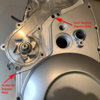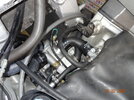There are two 'weep holes' on a ST 1300 motorcycle. They serve entirely different purposes and have nothing to do with each other. Because the two outlets (the "round hole" and the "square hole") are located very close together, this sometimes causes confusion.
I'm not sure which hole you are talking about... your question suggests that you are asking about the "round hole" (the water pump drain), but that hole is very unlikely to get plugged up. The hole that is at greatest risk of getting plugged up is the "square hole".
Below you will find a series of photos that illustrates the path liquid travels before it drips out of either one of these holes.
First, let's identify the two holes. The photo below is of a 2012 ST. Early production models did not have the metal elbow and rubber drain hose extension on this hole -they just had a round hole. I think the elbow and rubber hose were added at the beginning of model year 2007 or 2008 production.
Drain Holes

The round hole (upper hole) is the simplest and easiest to understand. It allows engine coolant to drain out of the water pump if there is a failure of the seals within the water pump. The two photos below show you everything you need to know about the approximately two-inch long path from the innards of the water pump to the round hole outlet on the side of the engine.
Front View of Round Hole
The snowflake-shaped thing is the water pump.
 Rear view of water pump
Rear view of water pump
You can see the little molded channel leading from the inside of the water pump to the round drain hole - look at the 4 o'clock position.

That's all there is to the round hole. Very simple, very straightforward, a very short drainage path that serves one purpose only. If you discover coolant (or, God forbid, oil) leaking out of the round hole, the water pump will need to be replaced.
- - - - - - - - - - - - - - - - - - - - - - - - - - - - - - - - - - -
The Square Hole
The purpose of the square hole is to drain liquid from the 'V' between the two banks of cylinders. The 'liquid' could be anything - perhaps clean water from sources external to the motorcycle that gets into the V between the cylinders when you are washing the motorcycle, perhaps oil that leaks from somewhere (who knows where) into the V, or (most probably) small amounts of engine coolant that leak from hose connections in the 'V' area.
The next series of pictures will follow the path of liquid that drains out of the square hole, but in reverse. In other words, the pictures will start at the outlet of the square hole and work their way back until reaching the bottom of the V at the front of the engine.
Front of Engine (Water Pump Cover Removed)
Here you can see the square hole outlet in the lower left, and the inlet to the channel leading to the square hole.
 Same picture as above, but before cleaning things up
Same picture as above, but before cleaning things up
When the water pump cover is installed, it creates a square channel that allows liquid and debris (usually sand that gets thrown up into the V by the rear wheel) to flow out the hole at the top, down the channel, and out onto the ground.
 The opposite side of the above photo
The opposite side of the above photo
The hole at the tip of the arrow is the same hole as the upper hole in the picture above.
 This photo is taken from the front of the moto, looking aft at the front of the engine, after the big cover in the three photos above has been removed.
This photo is taken from the front of the moto, looking aft at the front of the engine, after the big cover in the three photos above has been removed.
Note that the liquid (and debris) enters from the hole at the top, drops down about half an inch, then exits via the hole shown in the photo above. This chicane creates a problem: if there is a large amount of debris, the drainage path will plug up at this point, and it is very difficult to clean it out without full disassembly.
 Finally, where it all starts
Finally, where it all starts
This photo shows the drain hole in the V at the front, top of the engine. It is the opposite side of the photo directly above.

If the drainage path between the hole in the V shown directly above and the square hole on the side of the motorcycle (shown on the first picture at the very top) becomes plugged, water will not drain from the V between the cylinder banks. The bottom part of the alternator may become submerged in liquid, and debris that accumulates in the V may be carried into the alternator by the liquid.
I hope this answers your question.
Michael










